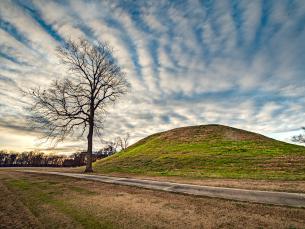
The state’s first Arkansas State Archeological Landmarks
By: Zoie CliftAmong Arkansas' 52 state parks are historic sites that help share and preserve the state’s rich and varied history. Their inclusion within Arkansas' state park system has helped preserve and protect them.
Three state parks holding significant historical importance were recently designated Arkansas State Archeological Landmarks, an official designation providing strengthened protection for sites significant to Arkansas’ aboriginal past.
The sites chosen, Plum Bayou Mounds Archeological State Park, Parkin Archeological State Park, and Davidsonville Historic State Park, were recognized in collaboration with Arkansas State Parks, the Arkansas Archeological Survey and the Quapaw Nation.
“The designation of these state parks, Plum Bayou, Parkin, and Davidsonville, as State Archeological Landmarks emphasizes the importance of these places to the history of the State of Arkansas,” said Melissa Zabecki, State Archeologist at the Arkansas Archeological Survey. “This designation provides additional legal protection and disturbance to them incurs additional penalties. We believe that these designations demonstrate how much the [Arkansas] State Parks and the Arkansas Archeological Survey are committed to protecting and preserving these places.”
All three parks were specifically chosen for their connection to different historic time periods.
“While most state parks in Arkansas possess important components that contribute to our understanding of the indigenous history of our state, these three represent different time periods and site usage and the three together encompass much of Arkansas’ Precontact time and also includes two thoroughly studied sites, Parkin and Plum Bayou, as well as a site that we could learn a lot more about, Davidsonville,” said Zabecki.
As of now, these three sites are the only State Archeological Landmarks in Arkansas, but there is potential for more sites to be added in the future.
“We just wanted to start with our close partner, [Arkansas] State Parks, and will hopefully work with other land managers in the future but there is a limitation,” said Zabecki.
Additionally, Plum Bayou Mounds Archeological State Park is a National Historic Landmark, one of only four in the Arkansas State Park system. It is also listed on the National Register of Historic Places and was Arkansas’ first archeological state park. Located near Scott and dating to a period in history known as the Late Woodland and Early Mississippian time periods, it was used as a ceremonial site. Today, it is the largest remaining ceremonial mound site in Arkansas.
Currently there are ten archeological research stations across the state, and each are a part of the Arkansas Archeological Survey. This includes Plum Bayou Mounds Archeological State Park and Parkin Archeological State Park.


Parkin Archeological State Park in Parkin was the location of an indigenous village dating from the Mississippian Period. Over the years, much has been learned about the people who lived there during this time. The village also has a connection to Spanish explorer Hernando de Soto, who is thought to have visited what is now Arkansas during his expedition in 1541.


Davidsonville Historic State Park near Pocahontas was home to Arkansas’ first planned town. Archeological excavations there have unearthed a great deal American frontier history. A longer history with artifacts found dating to the Archaic Period and through the Woodland and Mississippian Periods have also been found during excavations, providing the potential to learn more about these time periods in our state.






